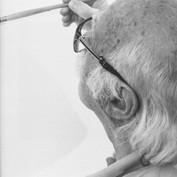
Biography
São Paulo, Brazil, 1920 —
São Paulo, Brazil, 2004
Hermelindo Fiaminghi reminds us why color and lighting are basic elements of visual arts. Its trajectory culminates in the purification of the painting to the minimum form, to highlight vibrations of light frequencies.
Although he became especially known as a painter and draftsman, Fiaminghi professionally engaged in the activities of graphics, advertising and lithograph, which constituted a significant part of his creative soil and kept him attentive to the development of industrial graphic technologies.
The first half of the 1950s brought great changes for the artist: in 1952, he ended his figurative production with the work Mulher Sentada, and began to explore constructive art, as can already be seen on the Vertical Composition I (1953) canvas. In 1954, the painter left the studio of his teacher, Waldemar da Costa, and the following year, invited by Luiz Sacilotto, he began to participate in the meetings of the Concreto Paulista Group. In the same period, Fiaminghi joined Grupo Ruptura, developing works focused on creating visual rhythms with an almost mesmerizing effect. Also at that time, the artist started experimenting with offset printing, being considered the introducer of this graphic process in Brazilian art.
In 1958, Fiaminghi’s works announced a new change of direction with the series Virtuais, which subtly introduces in the pictorial elements, admittedly concrete, a play of transparencies, light and shadows. This flow of transformations flows in the 1960s in an impressive way with Corluz, who not only names many of his works but also designates an aesthetic concept created by Fiaminghi to address, in his own work, the possibilities of generating and dissolving light from vibration produced by colors combined in a structured way. The exploration of this concept through the use of the language of the reticle, a typical element of the graphic world, materializes – or, paradoxically, almost escapes the material – in the radiance and joy emanated by works such as Retículo Corluz II (1961) and Retículo Corluz VII (1962 ).
The cocoons that Fiaminghi painted in the late 1960s and early 1970s seem to indicate a new flight; a flight that needs to be preceded by careful gestation, rested after the dazzling glow of true reticular suns. Then, during the 1980s and 1990s, in works such as Despaisagem Reticula Cor-luz (1985) and Corluz 9416 (1994), Hermelindo Fiaminghi took Corluz to his impressionist roots, Monet and Cézanne. The strength of this return to the past seems to be retroactive in a dialogue with the artist’s previous production and ends in a refreshing freedom: the release of the trace, the structure, the impalpable color.
GGS

